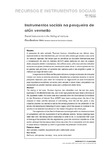Mostrar el registro sencillo del ítem
Instrumentos sociais na pesqueira de atún vermello
| dc.contributor.author | Barahona Nieto, Elisa | |
| dc.date.accessioned | 2009-11-10T11:51:43Z | |
| dc.date.available | 2009-11-10T11:51:43Z | |
| dc.date.issued | 2007 | |
| dc.identifier.citation | Ambientalmente sustentable 2007, 4: 99-108 ISSN: 1887-2417 | es_ES |
| dc.identifier.issn | 1887-2417 | |
| dc.identifier.uri | http://hdl.handle.net/2183/5056 | |
| dc.description.abstract | [Resumo] A pesqueira de atún vermello Thunnus thynnus, intensificouse nos últimos anos, especialmente no Mar Mediterráneo, por mor dos altos prezos que alcanza a súa carne no mercado xaponés. Hai tempo que os científicos da Comisión Internacional para a Conservación do Atún do Atlántico (ICCAT) veñen alertando do risco de colapso desta pesqueira debido á sobrepesca. Nos últimos anos, unha nova práctica industrial sumouse aos graves problemas de conservación deste stock: a cría e engorde de atún en gaiolas, que provocou un aumento das capturas para o seu engorde e posta no mercado ao longo de todo o ano. A negociación do Plano de Recuperación levou consigo un proceso de consultas intenso con todos os sectores afectados. Realizáronse numerosas reunións co sector pesqueiro implicado para tratar de incorporar na negociación as súas formulacións pola importancia económica do sector, pero sempre e cando fosen compatibles coa necesidade de adoptar medidas serias para a protección deste stock | es_ES |
| dc.description.abstract | [Abstract] The fishing of red tuna, Thunnus thynnus, has intensified over the last few years, especially in the Mediterranean Sea, due to the high prices red tuna meat is fetching on the Japanese market. For some time now scientists from the International Commission for the Protection of Atlantic Tuna (ICPAT) have been warning about the risk of the collapse of these catches because of over-fishing. Over the last few years, a new industrial practice has started to add to the serious problems for the protection of the stocks: the breeding and fattening of tuna in cages, which has caused an increase in the catches to be fattened and placed on the market throughout the whole year. The negotiation of the Plan for Protection has brought with it an intensive process of consultation with the involvement of all the affected sectors. Various meetings have been held with the fishing sector implicated in order to try to incorporate their ways of looking at the problem into the negotiations, given the economic importance of the sector, although this has always been done only when this is compatible with the needs to adopt serious measures by which to guarantee the protection of this stock. | es_ES |
| dc.language.iso | glg | es_ES |
| dc.publisher | Universidade da Coruña | es_ES |
| dc.subject | Atún vermello | es_ES |
| dc.subject | Cimarrón | es_ES |
| dc.subject | Recuperación-atún | es_ES |
| dc.subject | Instrumento social | es_ES |
| dc.subject | Red tuna | es_ES |
| dc.subject | Wild species | es_ES |
| dc.subject | Recovery-tuna | es_ES |
| dc.subject | Social instruments | es_ES |
| dc.title | Instrumentos sociais na pesqueira de atún vermello | es_ES |
| dc.title.alternative | Social instruments in the fishing of red tuna | es_ES |
| dc.type | info:eu-repo/semantics/article | es_ES |
| dc.rights.access | info:eu-repo/semantics/openAccess |






